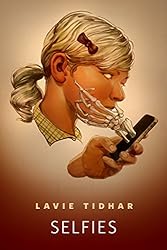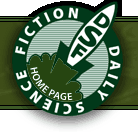Our exploration of free and inexpensive short fiction available on the internet. Here are a few stories we’ve read that we wanted you to know about.

![]() “Death and the Compass” by Jorge Luis Borges (1954, free online version)
“Death and the Compass” by Jorge Luis Borges (1954, free online version)
When Edgar Allen Poe goes in for creating an all-divining detective, you get “The Murders in the Rue Morgue”; when Gene Wolfe does it, you get “The Detective of Dreams”; when Jorge Luis Borges does it, you end up with “Death and the Compass”. No disrespect to Poe or Wolfe, who are both among the greats, but Borges’ creation might just be my favorite short story of all time. It’s only a fantasy in that it is set in a fictionalized Buenos Aires, not the real one; but it is permeated with the fantastic just as the grounds of Triste-le-Roy are permeated with “the boundless odor of the eucalypti.”
Our detective is Erik Lonnrot, who with his Lestradian colleague Treviranus is called to the Hotel du Nord to investigate the murder of the Jewish intellectual Dr. Marcel Yarmolinsky. Yarmonlinsky’s last words, typewritten on a single sheet, are “The first letter of the Name has been uttered.” From this striking beginning we go on to some pretty hilarious asides, an ironic interrogation of the detective story in general, kabbalistic mystery, dramatic geometry, vengeance and violent death.
I am not crazy about the Anthony Kerrigan translation at the link, but it’s adequate, and the brilliance of the story can’t be hid. Try it. It’s awfully good. ~Nathan Okerlund
![]() “Triquetra” by Kirstyn McDermott (2018, free at Tor.com, 99c Kindle version)
“Triquetra” by Kirstyn McDermott (2018, free at Tor.com, 99c Kindle version)
 In this “What happened next?” take on “Snow White and the Seven Dwarfs,” Fairest (Snow White) is married to her prince and living with him in his castle. They have a lovely, golden-haired seven-year-old daughter. And they have Fairest’s stepmother, imprisoned in their castle, along with the magic mirror that originally began all the trouble. Fairest visits her stepmother each month, when they share an apple from a magical tree (presumably grown from the poisonous apple of the tale) along with their latest idea of a gory, imaginative way in which to kill each other.
In this “What happened next?” take on “Snow White and the Seven Dwarfs,” Fairest (Snow White) is married to her prince and living with him in his castle. They have a lovely, golden-haired seven-year-old daughter. And they have Fairest’s stepmother, imprisoned in their castle, along with the magic mirror that originally began all the trouble. Fairest visits her stepmother each month, when they share an apple from a magical tree (presumably grown from the poisonous apple of the tale) along with their latest idea of a gory, imaginative way in which to kill each other.
The stepmother also warns her about the unspeakable intentions of Fairest’s husband, the prince, toward their daughter. Whether to believe her? The magic mirror might answer, but Stepmother warns Fairest against that as well.
“Heed me well, Fairest. When you stand before that thing, when you peer into its depths, you also allow it to peer into you. It will see the very darkest of your fears; it will sup on them and find them delicious. And it will use them against you in terrible ways.”
“Triquetra” is a dark subversion of the Snow White fairy tale, raising challenging questions about trust and the ways in which people can be misled. It’s imaginative, with vivid writing, but disturbing on several levels, not the least of which are the creative murder methods dreamed up by Fairest and her stepmother, which are used as a grisly framing device. I liked the way in which the stepmother’s character was recast, and the ultimate resolution of the story.
A triquetra is a triangular design with three interlocking, pointed loops, sometimes with a circle forming part of the design. It may be that the three points are intended to be Fairest, her daughter and her stepmother, but a few more interesting possibilities do come to mind. ~Tadiana Jones
![]() “Selfies” by Lavie Tidhar (2014, free at Tor.com, 99c Kindle version)
“Selfies” by Lavie Tidhar (2014, free at Tor.com, 99c Kindle version)
 “Selfies” is definitely a modern horror story by Lavie Tidhar — a young woman, Ellie, is running from something terrible at night, pursued by a mysterious “they,” though still snapping selfies as she flees for her life. Then, the reader discovers, Ellie seems to have gone mad and died (though it’s not the last anyone sees of her). So how did this all begin?
“Selfies” is definitely a modern horror story by Lavie Tidhar — a young woman, Ellie, is running from something terrible at night, pursued by a mysterious “they,” though still snapping selfies as she flees for her life. Then, the reader discovers, Ellie seems to have gone mad and died (though it’s not the last anyone sees of her). So how did this all begin?
Tidhar reels the narrative back to when Ellie finds her way to the nearly-abandoned back end of a mall, where an aggressive salesman convinces her to buy a sleek, thoroughly upgraded mobile phone. Ellie’s new phone makes her happy, at first, but the more selfies she takes, the stranger things get and the more she sees a twisted mockery of her own face in places where it should not be.
In the picture something with my face is standing outside and it’s looking back at me and it’s smiling.
The narrative skips and jumps around from photo #733 to #1 to #736 to #112 and more, sharing Ellie’s disorientation and confusion with the reader. “Selfies” is an inventive twist on the classic horror trope that a camera can steal a person’s soul, though it takes a little while to get truly terrifying, and Ellie’s internal monologue is a little stilted; it’s sometimes very obvious that Tidhar is an adult male author trying to sound like a teenage girl. But it’s still quite creepy, with spine-tingling imagery, and would make for an excellent short film. ~Jana Nyman
![]() “The Kite Maker” by Brenda Peynado (2018, free on Tor.com, 99c Kindle version)
“The Kite Maker” by Brenda Peynado (2018, free on Tor.com, 99c Kindle version)
 “The Kite Maker” is an alien invasion with a reverse twist: when the alien ships landed, humans attacked the dragonfly-like aliens who emerged from the ships, killing and maiming many of them. Eventually humanity figured out that the Dragonflies were friendly refugees from a dying planet and allowed them to settle among us on Earth. But shame, prejudice and xenophobia have made the arrangement an uneasy one. The narrator, a kite-maker and -seller whose homemade kites are adored by the Dragonflies, struggles with her own feelings and fears.
“The Kite Maker” is an alien invasion with a reverse twist: when the alien ships landed, humans attacked the dragonfly-like aliens who emerged from the ships, killing and maiming many of them. Eventually humanity figured out that the Dragonflies were friendly refugees from a dying planet and allowed them to settle among us on Earth. But shame, prejudice and xenophobia have made the arrangement an uneasy one. The narrator, a kite-maker and -seller whose homemade kites are adored by the Dragonflies, struggles with her own feelings and fears.
It’s an odd but thought-provoking tale, using both aliens and kites as obvious metaphors. The story is punctuated by a weird sexual assault perpetrated by the narrator on an alien for murky reasons. Not a comfortable story in any way, it carries a strong message. ~Tadiana Jones

![]() “Safe Space” by Rich Larson (2018, Daily Science Fiction March 17, 2018)
“Safe Space” by Rich Larson (2018, Daily Science Fiction March 17, 2018)
Gen is a refugee, newly arrived in Novapolis, a gleaming white, beautiful city with “custodians”: “small white spheres that moved through the air like schools of fish.” She’s on a floating balcony, looking over her new home, when a stranger appears on her balcony who has some thoughts to share about life in Novapolis.
I found this to be a relatively unoriginal story since the “overprotective AI/robot” seems to be a theme I’ve seen a lot, beginning decades ago (and I’m not sure any have improved on Jack Williamson’s “With Folded Hands,” though it’s been a while since I read it). I like that the main character is a refugee and wish more had been done with that; I also would have liked to have felt that more fully. There’s a bit of a twist, but it doesn’t save the story, and I’m not sure it’s as twisty or unpredictable as intended. ~Bill Capossere






In fairness, it would be hard to improve on “With Folded Hands”.
I still remember vividly how “With Folded Hands” appalled me when I read it in my 20s, years ago. It’s part of the 2-volume Science Fiction Hall of Fame novella collection, where I also first met up with “Who Goes There?,” “Vintage Season,” “The Moon Moth” and several other marvelous classic SF tales.
Hey, that’s where I read it too! What a great collection.
I stole Volume 1 of the SF Hall of Fame (the short stories) from my dad when I moved out of the house years ago, hah. The two volumes of novellas I bought on my own.
Come to think of it, I replaced my dad’s battered paperback of Volume 1 with a hardback copy several years ago. I probably ought to give his paperback copy back to him. :D
They’re all excellent collections. I cut my SF teeth on Volume 1, and it’s probably a major part of the reason I’m a lifelong SF fan.
Also where I came across many of my old favorites.